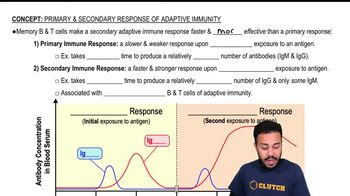Match the following choices to the statements in questions 5–7:
a. IgA
b. IgD
c. IgE
d. IgG
e. IgM
The first antibodies synthesized; especially effective against microorganisms.
 Tortora 14th Edition
Tortora 14th Edition Ch. 17 - Adaptive Immunity: Specific Defenses of the Host
Ch. 17 - Adaptive Immunity: Specific Defenses of the Host Problem 17.8a
Problem 17.8a Verified step by step guidance
Verified step by step guidance



Match the following choices to the statements in questions 5–7:
a. IgA
b. IgD
c. IgE
d. IgG
e. IgM
The first antibodies synthesized; especially effective against microorganisms.
How would each of the following prevent infection?
a. antibodies against Neisseria gonorrhoeae fimbriae
b. antibodies against host cell mannose
Match the following choices to the statements in questions 5–7:
a. IgA
b. IgD
c. IgE
d. IgG
e. IgM
Antibodies that are bound to mast cells and involved in allergic reactions.
Put the following in the correct sequence to elicit an antibody response: (1) TH cell produces cytokines; (2) B cell contacts antigen; (3) antigen fragment goes to surface of the B cell; (4) TH recognizes antigen fragment and MHC; (5) B cell proliferates.
a. 1, 2, 3, 4, 5
b. 5, 4, 3, 2, 1
c. 3, 4, 5, 1, 2
d. 2, 3, 4, 1, 5
e. 4, 5, 3, 1, 2
A kidney-transplant patient experienced a cytotoxic rejection of the new kidney. Place the following in order for that rejection: (1) apoptosis occurs; (2) CD8⁺ T cell becomes CTL; (3) granzymes released; (4) MHC class I activates CD8⁺ T cell; (5) perforin released.
a. 1, 2, 3, 4, 5
b. 5, 4, 3, 2, 1
c. 4, 2, 5, 3, 1
d. 3, 4, 5, 1, 2
e. 2, 3, 4, 1, 5
NAME IT A purified protein from Mycobacterium tuberculosis is injected into a person’s skin. A hardened, red area develops around the injection site within 3 days.